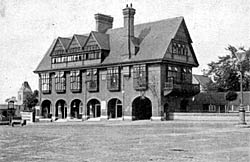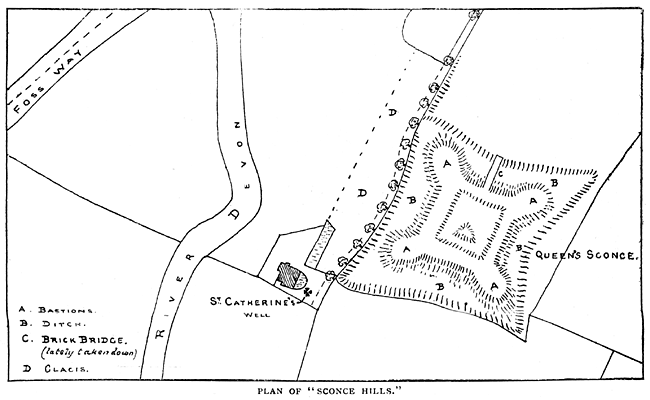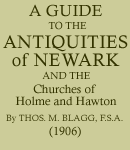< Previous | Contents | Next >
Modern buildings.
Of the modern buildings in the town it is not within the province of this guide to speak. Suffice it to say that THE ROMAN CATHOLIC CHURCH was built in 1837. Its first priest was the scholar, Dr. Waterworth. He had here a private school for sons of the old Roman Catholic families of England. Among his pupils was the Sir Roger Tichborne whose disappearance led to one of the most famous impostures of modern times.
CHRIST CHURCH is an ugly white-brick building, erected in 1837.
ST. LEONARD'S CHURCH was built in 1873. It is in the Early English style, and contains an expensive Reredos.

Ossington Coffee Palace.
THE OSSINGTON COFFEE TAVERN, which forms so conspicuous and imposing a feature when Newark is entered from the Great North Road, was built in 1882, being founded by a lady, (as the lozenge on its swinging sign proclaims) Viscountess Ossington, a daughter of the fourth Duke of Portland, in memory of her husband, Mr. Speaker Denison. It is a Temperance Hotel, with assembly rooms, and is administered by a body of public trustees, any profit resulting from its trade being devoted to the Newark Hospital. It is a magnificent building in the late Tudor style, with a fine series of leaded oriel windows. Visitors should go upstairs into the Assembly Boom in order to realise the lavish scale upon which this splendid and useful memorial was constructed.
THE GILSTRAP FREE LIBRARY, already alluded to in the account of the Castle, stands in the public gardens. It was built and presented to the town by one of its natives, the late Sir William Gilstrap, in 1883, and is partially endowed. It contains a very good reference library for so small a town.
The Corporation Plate.
Having mentioned the Church Plate, that of the Corporation should not be passed over without notice. One famous piece it has which is known to connoisseurs thoughout England—that is the "Newark Monteith." A monteith was a vessel used for cooling wine-glasses. The Newark example was given to the Corporation, together with thirteen silver cups, by Nicholas Saunderson, in 1689, and bears the date-mark of 1686. It is a silver bowl, eleven inches in diameter, with a movable rim, scalloped on the edge so that wine glasses could be hung from it, bowl downwards, in the iced water. A monteith, like a macintosh, derives its name from its inventor. As Dr. King wrote—
"New things produce new words, and thus Monteth,
Has by one vessel saved his name from death-"
Thirteen silver cups, beaker-shaped, with the date-mark of 1688-9, accompany this bowl. The number thirteen is consequent upon the town being governed at that time by a Mayor and twelve aldermen; the thirteenth or Mayor's beaker is provided with a loose lid surmounted by a talbot, or little dog, the crest of the donor. Among the remainder of the Corporation Plate and Eegalia should be mentioned:—
The Mayor's Wand, date 1617.
A Small Drum Tankard, with flat lid; Hall mark, 1641.
A Tankard of 1667.
The Great Mace, 3 feet 10 inches long, of silver gilt; temp.
Charles II. The Lesser Mace, 35 inches long, silver gilt; also temp. Charles II.
Framed, and hanging in the Council Chamber at the Town Hall, may be seen the original Grant of Arms to the Borough, emblazoned on vellum; it was issued by Garter King of Arms, in 1561. Not many boroughs have preserved an original grant of so early a date.

The Sconce Hills.
At the southern end of the town, where the Fosse Way passes out, may be seen in an almost perfect state of preservation one of the most important of the town's defensive earthworks during the Civil Wars. This, the "Queen's Sconce," is locally known as the "Sconce Hills." Square, with very bold bastions at each angle, and immense depth of ditch, the visitor should not fail to inspect what is probably the most perfect specimen of seventeenth century field fortification now remaining in England. The accompanying plan will serve as a guide better than a technical description. The companion earthwork on the northern side of the town— the "King's Sconce,"—has now been completely cut away, its site in Northgate being partly occupied by Mr. Farrar's foundry. Nearer Winthorpe, however, on the east bank of the river, close to Crankley Point, can be traced the perfect outline of a similar fort, known now, presumably from its shape, as the "Star Fort," which the rebels threw up in order to command the river and prevent supplies from coming into the town by boat. Though intersected by a hedge, its grassy ramparts and bastions are plainly discernible.
St. Catharine's Well.
Close to the "Queen's Sconce," and marked on the accompanying plan of it, will be noticed a well, standing in a cottage garden. This is known as "St. Catharine's Well.' The legend attached to it is given at length by Dickinson in his history of Newark (pp. 25-1-257). Suffice it here to say that a fair damsel of Newark, Isabel de Caldwell, had two lovers, Sir Everard Bevercotes and Sir Guy Saucimer. The rivals, very naturally, fought it out, and Sir Guy slew Sir Everard by the Devon bank, on St. Catharine's eve. Where the body of Sir Bverard fell this spring gushed out, and has never since failed. Sir Guy fled to foreign lands. Isabel died of grief. Crime-weary, remorseful, stricken with leprosy, Sir Guy returns home. On his way the holy Catharine appears to him in a vision, and tells him that where his crime was committed is the only water that can cure his leprosy. And so he built himself a hermitage on this spot, and a chapel to St. Catharine, and "lived a sad and godly life," much venerated by all hereabouts, by whom he was known by the name of St. Guthred.
All the actors in this tragedy bear local names, those of Caldwell and Saucimer occurring among the chantries founded in Newark Church. Some years ago a carved stone head, apparently a dripstone terminal, was found near the well, possibly a fragment of the tiny chapel. A photograph of it is reproduced in the Reliquary. 1896, p. 52.

